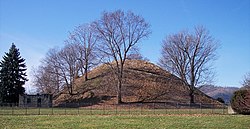
Back جبل جراڤ كريك موند ARZ Grave Creek Indian Mound CEB Grave Creek Mound Dutch Grave Creek Mound Polish
Grave Creek Mound | |
 Grave Creek Mound in 2006 | |
| Location | Tomlinson and 9th Streets, Moundsville, West Virginia |
|---|---|
| Coordinates | 39°55′00.86″N 80°44′40.49″W / 39.9169056°N 80.7445806°W |
| Built | 250–150 BC |
| NRHP reference No. | 66000751[1] |
| Significant dates | |
| Added to NRHP | October 15, 1966[1] |
| Designated NHL | July 19, 1964[2] |
The Grave Creek Mound in the Ohio River Valley in West Virginia is one of the largest conical-type burial mounds in the United States, now standing 62 feet (19 m) high and 240 feet (73 m) in diameter.[3] The builders of the site, members of the Adena culture, moved more than 60,000 tons of dirt to create it about 250–150 BC.
Present-day Moundsville has developed around it near the banks of the Ohio River. The first recorded excavation of the mound took place in 1838, and was conducted by local amateurs Abelard Tomlinson and Thomas Biggs.[4] The largest surviving mound among those built by the Adena, this was designated a National Historic Landmark in the mid-20th century.
In 1978 the state opened the Delf Norona Museum at the site. It displays numerous artifacts and interprets the ancient Adena Culture. In 2010, under an agreement with the state, the US Army Corps of Engineers gave nearly 450,000 artifacts to the museum for archival storage. These were recovered in archeological excavations at the site of the Marmet Lock, and represent 10,000 years of indigenous habitation in the area.[5]
- ^ a b "National Register of Historical Places – West Virginia (WV), Marshall County". National Register of Historic Places. National Park Service. February 8, 2007.
- ^ "Grave Creek Mound". National Historic Landmark summary listing. National Park Service. Archived from the original on October 28, 2009. Retrieved October 14, 2007.
- ^ Hemmings, E. Thomas (1984). "Investigations at Grave Creek Mound 1975-76: A Sequence for Mound and Moat Construction". West Virginia Archeologist. 362: 3–49.
- ^ Townsend, Thomas (February 2, 1839). "Grave Creek Mound". Cincinnati Chronicle.
- ^ Steelhammer, Rick (April 2010). "West Virginia lock and dam construction unearths finds". indiancountrynews.com. Archived from the original on March 3, 2016. Retrieved May 6, 2015.
© MMXXIII Rich X Search. We shall prevail. All rights reserved. Rich X Search